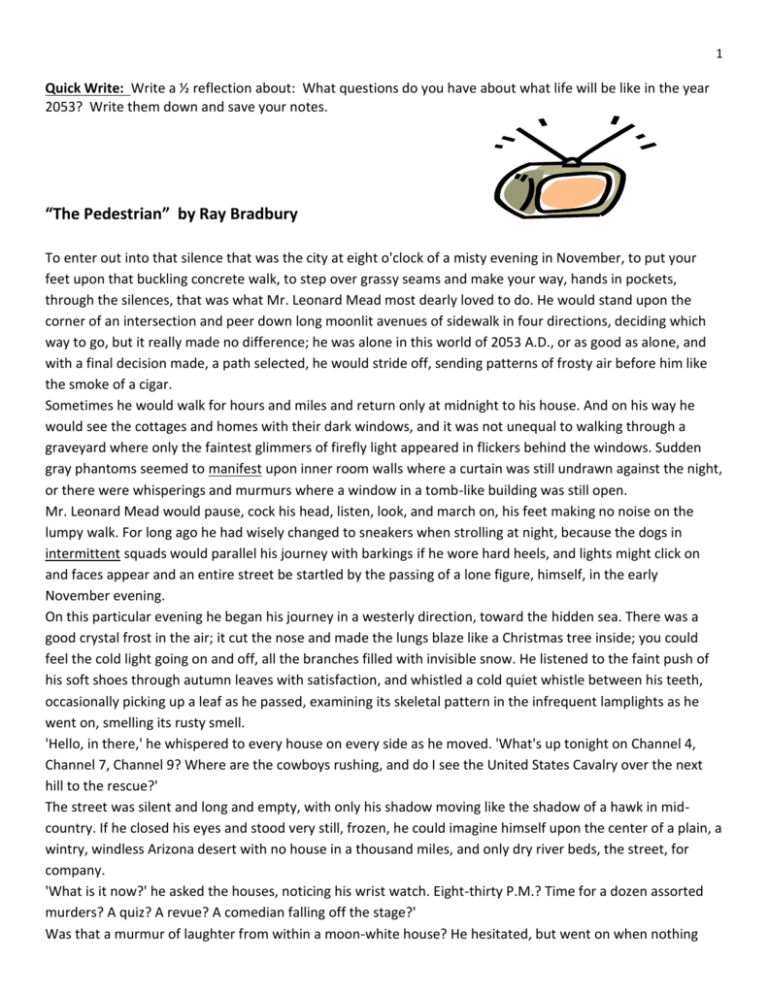

Mead is brought into a parallel with the most tender and human holiday observed in the western world when the rush of cold air makes his lungs "blaze like a Christmas tree" (104). Mead's shadow is described as the "shadow of a hawk," relating him to a wild and free-spirited bird (104). Man is most human when surrounded by the elements. Leonard Mead most dearly loved to do" (104). Something as simple as taking a walk is "what Mr. Since literature not only records the history of mankind but also evokes deep feeling among men, it brings this occupation close to the heart of humanity. Mead's house beams "loud yellow illumination" (105). In essence, the embodiment of humanity is about. If, during his night walks, people are alerted to his presence, "lights.

Mead is associated with warm, bright light, which is symbolic of soul. Through characterization and imagery, he shows that if mankind advances to the point where society loses its humanity, then mankind may as well cease to exist.īradbury has elected to reflect the humanity of mankind in the character of Mr. In "The Pedestrian," Ray Bradbury has chosen to make a statement on the effects of these improvements. However, as children give up reading and playing outdoors to plug into the television set, one might wonder whether it is progress or regression. Web.Mankind has made great leaps toward progress with inventions like the television. Bradbury’s “The Pedestrian” provides a chilling warning for society if it follows this trajectory, becoming a shadow of humanity while under control of technology and those who yield it. However, despite being bombarded with information, people become less intelligent, losing focus and memory despite being interconnected on social media, people are more secluded and private in a physical sense. Technology is so rapidly developing, that people are unable to determine its impacts. There are numerous benefits to technology, but at the societal level, driven by the industries of social and mass media, it has become a tool of conformity. It would be a quiet succumbing of humans to their own desires and media devices, where we become slaves to the very technology which was meant to enrich our lives and bring us together.

Except the irony is that in a scenario like that, it will not be a brave war of humans against the machines as shown in Hollywood movies. Referring back to dependence of society on technology, the dystopian future could very well be the technology controlling humanity. In the film version, Meade remarks with irony, that the government could all be dead for all they know, while the robots continue to go around patrolling the streets. As he had expected, there was no one in the front seat, no one in the car at all” (Bradbury, 1). In a world where the population engages in nothing else but the media, there is nothing left to do but control the dissidents.Īmazingly, in the “The Pedestrian” this is not even done by humans, but by police robots, “as he passed the front window of the car he looked in. It is well-known that media and entertainment has been always been used by those in power to control and instil ideology. Not much is told about the government present in the dystopia of “The Pedestrian.” It has eerie parallels to another of Bradbury’s novels “Fahrenheit 451” where similarly the population was engaged in their ‘talking walls’ of television media, while anyone who chose to read or behave uniquely, was brutally arrested. The story tells the consequences of a society dependent on technology, and how technology will become the central factor of control over human society. It is conformity at unprecedented levels in some societies – and deviation from it, such as limiting smartphone or social media use is oftentimes viewed as strange, even resulting in social disconnection. Most people watch a concert or fireworks through the recording camera of the smartphone to share later on social media, while the newest generation of kids prefers virtual realities rather than playing outside. Smartphones are prevalent everywhere, in every social occasion or venturing. “The Pedestrian” was written in 1951, when televisions just began to appear in homes on a massive scale, but fast forwarding 2-3 generations later, and the resemblance, at least in ideology, is uncanny. It dehumanizes the very human elements in people by creating an illusion of the emotions and experiences via television. The dystopian element to this story is not that individuals enjoy watching television, it is the fact that it has become a uniform activity (potentially used for control) which supresses thought, belief, and observation. Bradbury creates a juxtaposition that the next generations will continue to become engrossed in their personal technology, ceasing to pay attention to the world around them. Ray Bradbury’s “The Pedestrian” creates a dystopian and inherently antisocial society in which mass media via television envelops everyone in society.


 0 kommentar(er)
0 kommentar(er)
